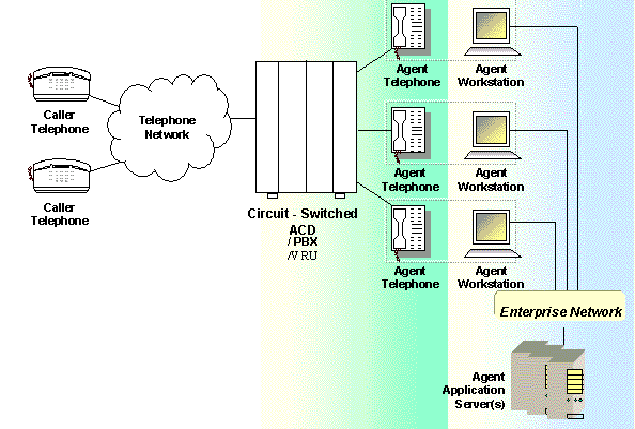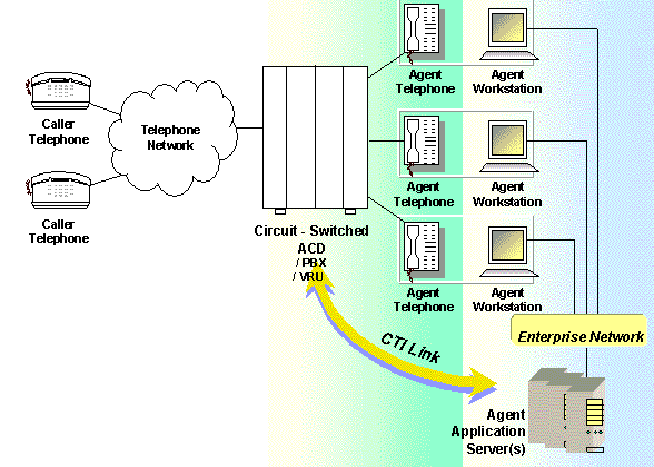
Call Center Technology without CTI:
The core of any call center
is the call processing switch, either an ACD
(Automatic Call Distributor) or a PBX
(Private Branch Exchange, which means Private Telephone Switchboard) with
ACD features. The PBX has evolved considerably from a human being sitting
in front of a switchboard, sending calls to the various extensions. Today,
a PBX can make announcements, collect user input, provide routing/call
handling, and log telephony events. Some PBXs can perform ACD functions,
and some can route the call to an agent based on the agentís skills. However,
a PBX can not transfer information about the caller, or perform sophisticated
call qualification, or log application-specific call events. As we will
see in following sections, these aspects are required in a complete CTI
solution.
In addition to a PBX, a call
center could also have VRUs (or IVRs
- Interactive Voice Response-). These units add new capabilities that place
the call center even closer to the CTI functions. A VRU can perform long,
complex user interactions (multilevel menus), call external functions,
interact with proprietary databases allowing to call qualification, perform
rudimentary software telephony services by using the VRU script language,
and allow caller-specific reporting. However, a VRU does not provide a
complete CTI solution either. A VRU cannot provide a common data repository
(for example, VRU databases cannot be accessed by the agent), or provide
efficient call qualification (very system-consuming), or easily provide
sophisticated telephony services.
Having PBX and VRU functionality
in mind, ďFigure IĒ illustrates the starting point for the modern call
center, and is still the state of the art for many call centers today.
Calls are received by a circuit switched PBX, which automatically distributes
them to agents according to the rules which it has been supplied. An agentís
workspace also includes a computer workstation connected to one or more
computer applications. Only the mind and hands of the agent connect the
agentís telephone and the agentís workstation. There is also a VRU system
greeting callers, prompting them for identification, and providing some
information automatically. However, if the call reaches an agent, the agent
will have to ask the caller to repeat the identification information. Obviously
call centers needed to take a step further and incorporate new technology
that close the gap between the two worlds: computer and telephony.
FIGURE I

Call Center Technology with CTI
As mentioned earlier, neither
PBXs nor VRUs provide the functionality necessary to build computer telephony
integration. A comprehensive CTI solution involves seamlessly integrating
telephone hardware, computers, and software. This integration depends on
some basic features or requirements that CTI must provide. First, there
must exist a unique, common data repository; thus, every component whether
is hardware, software or agent has only one place to look for information
about a call. Second, the caller must be qualified as early, quickly, and
automatically as possible. This allows companies to serve its customers
needs in a more efficient and cost-effective way. Third, the solution must
provide the agent with as much complete picture as possible about the caller
and the call, including the call history. This way, information can be
used to route calls to an appropriate agent as well as to trigger an appropriate
application on the agentís desktop. Fourth, since most enterprises have
heterogeneous mix of telephony and computer hardware and software, a good
CTI solution should be able to work with the existing call center equipment.
Finally, the last requirement is to provide also seamless integration of
the telephone, computer, and applications on the agentís desk. Thus, the
agent is able to perform all his/her telephony activities from his/her
computer including answering the phone, transferring calls, putting calls
on hold, placing conference calls, and hanging up. For more information
about features of a CTI solution see Quintus Technology Paper titled "Understanding
CTI."
The addition of a CTI link
adds much to the agentís ability to respond to callers efficiently, as
is shown in ďFigure IIĒ. The link allows the components of a call center
Ė telephone switches (PBXs), interactive voice response units (VRU), agent
workstations, and databases containing customer information Ė to work together
effectively. The agentís telephone and his/her workstation-based applications
can work together automatically. At a minimum, when a call is delivered
to the agent via telephone, relevant information about the call, whether
provided by network signaling or through VRU interaction, is delivered
at the same time via the workstation.
FIGURE II
